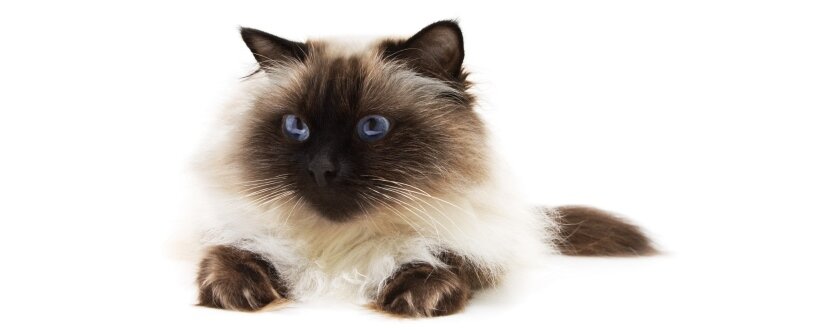



The Himalayan cat breed, also known as the Himalayan Persian or the Colourpoint Persian in Europe, was bred by crossing the Siamese with the Persian cat breed to achieve the color points and blue eyes. By 1924, a Swedish geneticist crossed the Persian and the Siamese cat breeds. By 1931, cat breeders began breeding both cat breeds to see how the color point gene was passed on. That said, by 1935, the first Pattern Longhair was developed. It was determined that both the longhair gene and the color point pattern gene was recessive.
Brief History
The lap-sitting, sweet and docile Himalayan cat breed was developed by Virginia Cobb, a cat breeder, and a Harvard Medical researcher, Clyde Keeler. Through interbreeding, both developed longhaired cats with Siamese color points. Newton’s Debutant was the first Himalayan kitten. The Cat Fancier’s Association determined that the Himalayan Persian is a color variation of the Persian cat breed.
By the 1950’s cat breeders from the U.K and the U.S tried to breed a Siamese Pointed Persian cat breed. By adhering to Cobb & Keeler’s genetic research to get the colorpoint pattern, cat breeders then bred the cats back with the Persian cat breed. The Cat Fancier’s Association (CFA) recognized the Himalayan as a distinct cat breed in 1957. Yet, in 1984 they decided to classify this breed as a color variety of the Persian cat breed. Himalayans today are named Pointed Pattern Persians.
The American Cat Association (ACA) also recognizes the Himalayan as a color variety of the Persian cat breed. That said, the International Cat Association (TICA) recognizes the Himalayan as belonging to the Persian Group, which includes Siamese and Exotic Shorthair. The American Association of Cat Enthusiasts, the American Cat Fanciers Association (ACFA), and the Traditional Cat Association are all registries that recognize the Himalayan as a separate cat breed.
Physical Description
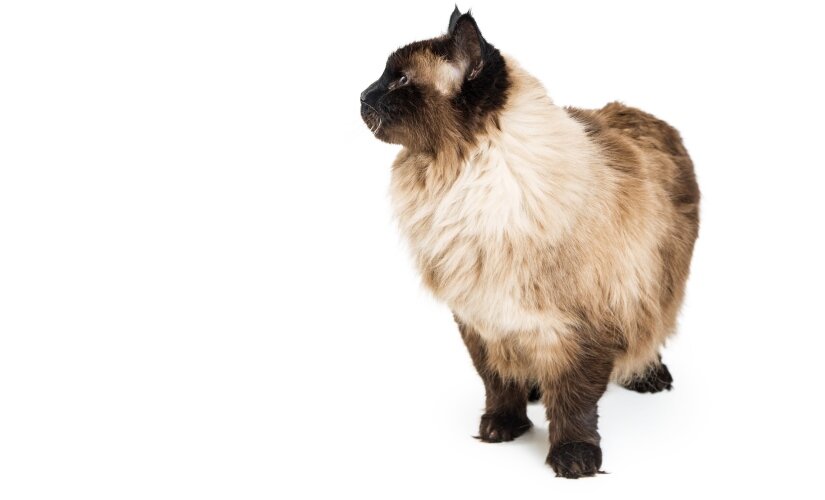
With a round body and short legs, the Himalayan cat breed is very similar to the Persian cat breed. The difference being the colorpoint and eye color. The head is round and large. The eyes are wide set and large. The nose is short, and the cheeks full. The ears are small, and have rounded tips. The body is strong and powerful with a short and thick neck. The Himalayan cat breed is a muscular cat breed that is well-built. The coat is light-colored, and the facial, ears and tail color are darker than the body color. The main coat color on the Himalayan is white or cream. That said, the points come in a variety of point colors such as chocolate, red, lilac, and many more. The eye color can only be blue like the Siamese.
Temperament
The Himalayan Cat breed is a docile and kind cat breed that enjoys being pampered. The Himmie may get slightly anxious or clingy if not exercised, or mentally stimulated. The Himalayan fancies lots of cuddles and cute cat toys. This cat breed can be aloof when needing time alone, but is also affectionate with immediate family. Himmies do well in a quiet home where nothing unusual happens.
This wonderful cat breed tends to be placid in nature, and are friendly with strangers. The Himalayan enjoys being groomed and played with. This cat breed is serene and needs a quiet home environment with no loud noises or stressful situations. Children need to be calm and gentle with this cuddly lap cat. This cat breed needs to be socialized during kittenhood so that they do well with other animals in the household. As usual, aggressive dogs should not be near the Himmie or in the same household.
Special Needs
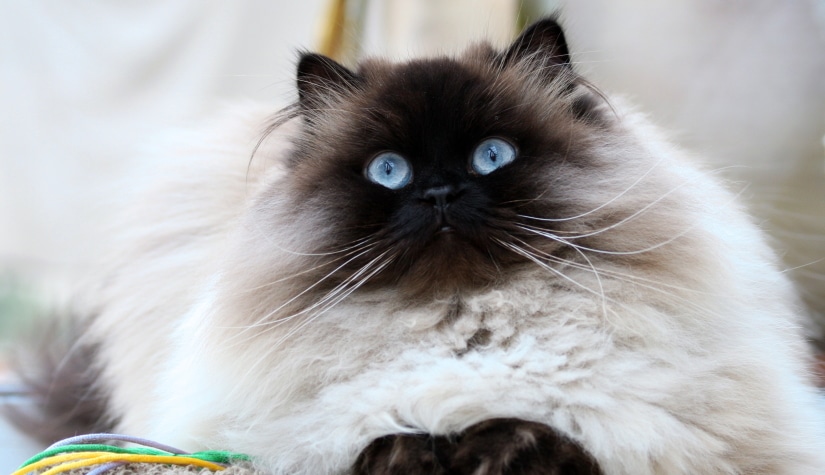
With numerous disorders and diseases that can affect your Himmie, it’s always best to stay on top of veterinary issues. If your cat shows any signs of illness, consult with your veterinarian right away. There are also inherited common disorders caused by genetic defects that may include deficiencies of certain enzymes. There are also interactions between your cat’s environment and genetic factors. Keep your Himmie healthy, vaccinated, and on a high-quality diet specific to his life stage.
The Himmie does best as an indoor cat. This cat breed thrives on affection, and plenty of interactive cat toys. The Himmie is docile, and does well with apartment living or home living. Cat parents need to ensure that the Himmie is always safe, and not in the same environment as an aggressive dog breed or rough children. This cat breed needs plenty of gentle TLC!
The Himmie needs to be indoors during the hot summer months, as it is heat sensitive. It is a wonderfully easy cat breed to live with, but does need mental stimulation. This cat breed gets bored when alone for long periods of time. Consider getting a pet sitter or another cat to keep your Himmie company if you’re out at work for most of the day!
Eye tearing may be a problem with this cat breed. Inactive cats tend to pick up weight, and are prone to more medical conditions, like liver disease. Daily grooming needs to be a priority with this cat breed. Socialization and litter box training should take place during kittenhood. Positive clicker training for cats is effective in teaching your Himmie cat games.
Exercising cats is tons of fun and is made easy by purchasing certain cats toys to promote exercise. Litter box training needs to start during kittenhood. With so many types of litter boxes and litter available, shopping for your feline is always exciting. All cats are super clean animals, so it is very easy to litter box train. Litter boxes for cats need to be kept clean, or your cat may not use it. All cats will need parasite control and routine health care throughout its life. This means vaccinating your cats. This is an important part of keeping your cats healthy throughout their lives. Your Himmie will also need to be spayed or neutered.
Consult with your veterinarian, and always consider veterinary health insurance for your cat. Special care needs to be given to the Himmie’s health needs.
Possible Health Concerns
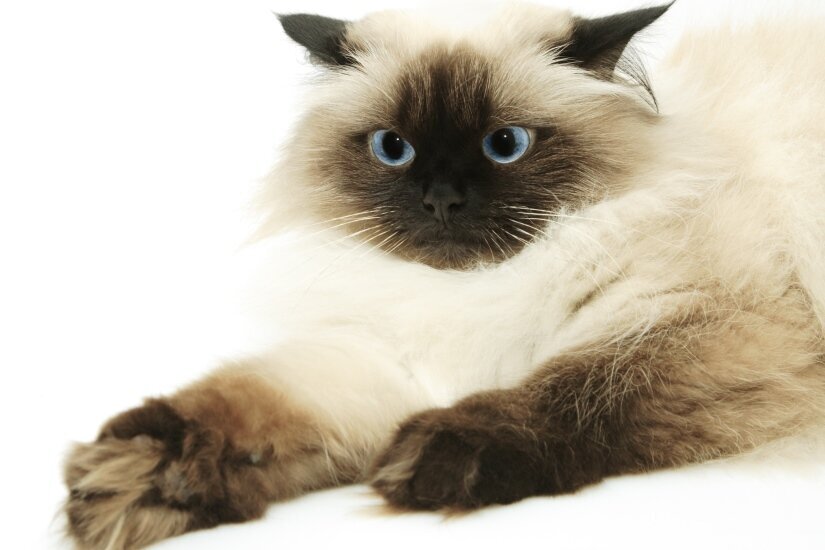
The Himmie is a healthy and moderately active cat breed that may be susceptible to the following health conditions:
- Polycystic Kidney Disease. This occurs when the polycystic kidney has numerous cysts within the functioning part of the kidney resulting in enlarged kidneys. Consult with your veterinarian if your cat vomits frequently, has a decreased appetite, and increased thirst or urination.
- Heat Sensitivity: Cats will sweat through their foot pads. The Himmie needs to be kept indoors during the hot summer months. This cat breed needs lots of fresh water to drink, cool places to lie in, and a cool home during extreme summers. Flat–faced cats have breathing problems, and don’t pant as well as other cat breeds. Symptoms of heat exhaustion include a fast heart rate, sunken eyes, and excessive panting. If your cat is a senior cat or is obese, it will be necessary to watch closely for heat exhaustion.
- Ringworm: This is an infection of the skin, hair, or claws, and is caused by a fungus called dermatophyte. This occurs in 98% of cats. It spreads easily from cats to people. Symptoms include circular, bald patches that scale and have broken hairs in a ring-like fashion. Consult with your veterinarian for advice.
- Skin Disorders: The Himmie may be prone to skin disorders. Himmie cats are prone to idiopathic seborrhea. This is an inherited skin disorder resulting in the overproduction of an oily substance. This clumps in the cat’s fur, and causes it to smell bad. Symptoms include red and irritated skin with excessive scratching. Consult your veterinarian for advice.
- Cherry Eye (Eyelid Protrusion): This is a disorder of the third eyelid, resulting in swollen redness of the eye. It is more common in Persian- related cat breeds. Consult with your veterinarian for advice.
- Basil Cell Carcinoma: These are malignant tumors that occur most often in elderly cats. The Himmie cat breed is very susceptible to this. They will first show up as ulcers on the head, legs, or neck, and are not raised from the skin. Instead they will spread and form new ulcers. Surgery is the best treatment for removal. These tumors will spread to other areas of the skin, but not to organs.
- Progressive Retinal Atrophy: This is a group of diseases that cause degeneration of the retina. This also includes inherited abnormalities of the light-sensitive retina layer. Cataracts are common toward the end of PRA. This results in it being difficult to detect underlying diseases of the retina. Consult with your veterinarian.
- Entropion: This is the inversion of the lower lid. It is more common among purebred cat breeds like the Himmie.
Exercise
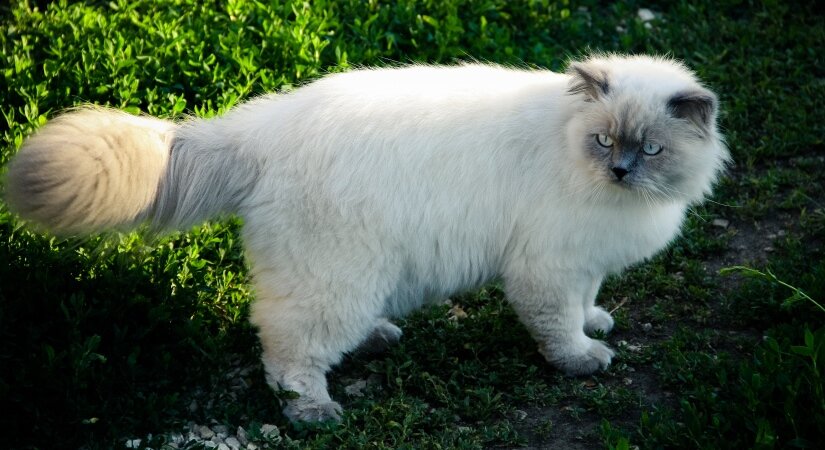
The Himalayan cat breed needs daily exercise combined with plenty of mental stimulation through active play and interaction with people. Cat parents can use cat toys like the Mousr or Cat Dancer to get their cats to play. This will encourage your cat to play. Finding a variety of mentally stimulating cat toys will allow for your cat to lead a well-balanced life, with the right amount of exercise and mental stimulation. Cat harnesses also allow for daily walks.
The Himmie is a sedate, and rather reserved cat breed, that thrives on attention. Some are shy, but all are very sweet natured. That said, this cat breed still needs to play and interact with people. Cat gyms, cat scratchers, and interactive cat toys within a cat friendly home environment work best for this fabulous cat breed.
Look out for the latest cat toys like Ripple rug play mats, the Feather Whirls, pet cube toys, food trees, turbo scratcher toys, cat companion interactive toys, and electronic motion toys. All these and many more will keep your Himmie kitty entertained when you’re out and about.
Nutrition
Always take notice of your cat’s eating behavior. If your Himalayan suddenly has a lack of appetite, it could indicate a serious illness. That said, if after a day, he’s still not eating, visit your veterinarian. Fresh, clean water needs to always be on hand for your Himmie. Canned cat food contains moisture, yet water should never be withheld from your cat. By feeding the proper amounts of cat food, you’ll also prevent your Himmie from becoming obese. Healthy cats are less prone to heart disease, arthritis, and a shorter lifespan.
The Himalayan cat breed will need proper nutrition. That said, a high-quality diet that is appropriate for the specific life stage of the cat is necessary. Protein as an ingredient, needs to come first. Dry cat food is a popular choice because it promotes healthier gums and teeth. Yet, wet food is highly recommended by veterinarians because it provides more moisture to cats. Cats don’t drink a lot of water and tend to sometimes get dehydrated. Wet cat food also has its benefits. By choosing a well-known name- brand cat food that has scientific backing, as well as quality control, cat parents can be assured that they are providing a well-balanced diet.
All cat breeds need high-quality fat and protein in their diets. They also need amino acids, including taurine that cannot be found in either human food or dog food. There are also numerous specialty diets for your cat that are formulated specifically for certain medical problems like urinary tract disorder, obesity, or kidney disease.
All cats do well by being fed twice daily. During kittenhood, kittens will need to be fed every few hours. Growing kittens need more calories, nutrients, vitamins, protein, and calories. Your Himmie cat should be able to enjoy a peaceful meal in a quiet corner of the house. Some cat parents prefer to leave cat kibble out 24/7. When looking for a high-quality cat food, here’s what to look out for:
- No low-quality fillers
- No artificial additives
- Low grade ingredients or toxic ingredients
- All cat food has to be meat-based because all cats are carnivores
- No garlic
- Plant-based ingredients should be listed after the protein-based ingredients
Consult with your veterinarian for the best dietary advice for your Himmie.
Grooming
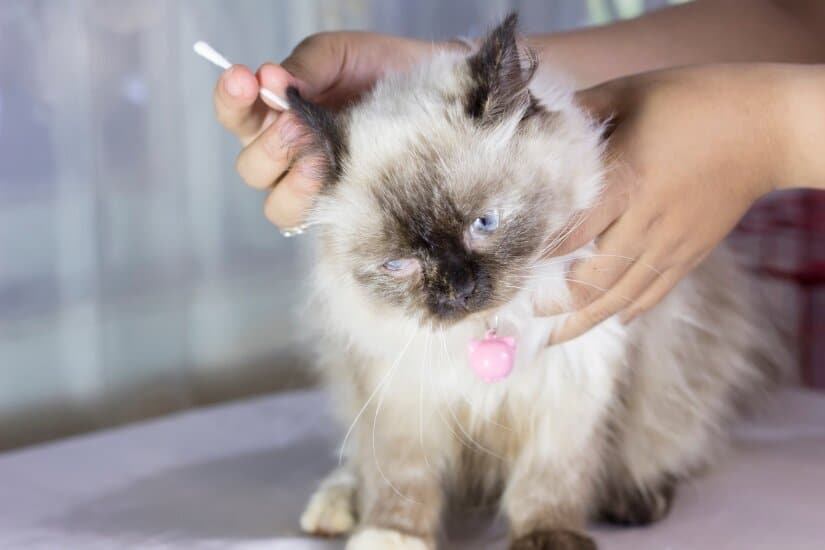
The Himmie needs daily grooming to remove shedding hair, and to prevent hair from matting. Because this breed has a long and wonderfully soft coat, extra grooming care is required. This cat breed has a neck ruff with thick hair, as well as thick tufts of hair between the front legs, toe hair, tufts of hair in the ears, and a fabulously thick tail. Stainless steel combs help to remove dead hair. Care must be taken when grooming leg hair and body hair to avoid missing spots that could tangle or mat easily. Curry brushes help with grooming, and will remove dead hair and debris from your cat’s coat.
Look for high-quality pet products to decrease shedding, and help prevent hairballs. Products like the Furminator will easily groom through your cat’s topcoat, and safely remove dead hair without hurting your cat. Soft tip massagers, deluxe nail trimmers, and de-shedding tools all help make cat grooming so much easier.
All cat breeds will groom themselves several times throughout the day. Daily grooming is necessary because it limits the amount of hair that your cat will consume. This helps limit the development of hairballs. Your Himmie will enjoy being groomed. Coat hair always looks best during the cold winter months. Cats that have been spayed or neutered will have great coats year- round. This is because hormonal changes in cats affects coat length and thickness.
Cat parents can remove mats by using cat clippers which are safer than using scissors. Daily cleaning with pet wipes beneath the tail is necessary. Ears should be checked weekly for cleanliness and sensitivity. If there is a build-up of wax and dirt, organisms can lead to an ear infection. Consult with your veterinarian about safe and gentle ear cleaning techniques. Nail trimming is necessary every few weeks. Eyes should also be cleaned gently every morning with cotton wool or a soft wipe. Each eye should be cleaned with different wipes or cotton balls to avoid eye infection contamination in both eyes.
Healthy Himmies need minimal bathing with a gentle cat shampoo. Your cat will need dental care as well. By feeding dry food, and having professional dental cleanings with your veterinarian throughout your cat’s lifetime, your cat will have less of a chance of developing gingivitis or gum disease.
Adopting a Himmie
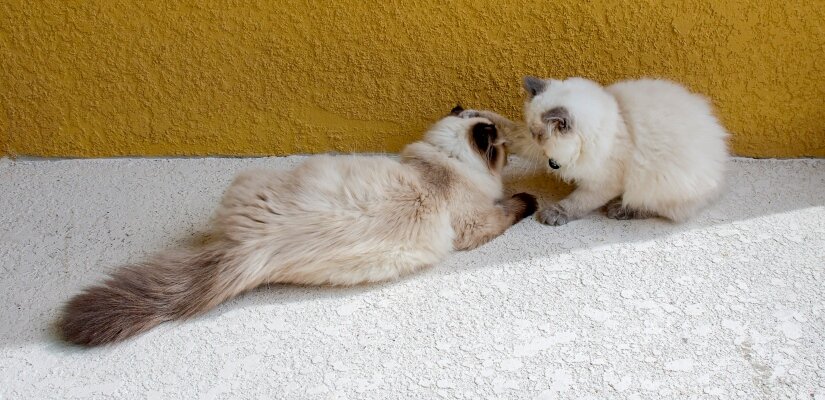
Feline pet parenting is a long term commitment, and carries responsibilities that need to be taken seriously. That said, before adopting any animal, take the time to think about the long -term responsibilities.
The Himmie has a compliant, and laid back temperament These cats are wonderful to live with. The magnificent Himmie easily adapts to new environments. That said, like all cats, the Himmie needs to be in a relaxed environment, or it will become stressed. Without a doubt, it is the Himmie’s beauty and perfect temperament that earns them a favorite spot in every cat lover’s heart as best feline companions. The Himmie is shy, yet friendly, and has impeccable manners!
Himmies deserve the very best home with feline pet parents geared towards their cat’s needs. This breed, although sturdy and well-built, is delicate health wise, and may be prone to numerous health conditions. It is up to cat parents to have the ability to sense when their Himmie is not feeling well, and to consult with their veterinarian.
Regular veterinary care is a must for this outstanding cat breed. This will help to curb any health issues early on, and prevent the onset of more serious health problems. As with all cats, it’s necessary to consider pet insurance for your Himmie. Be sure that you are able to afford good feline veterinary care before adopting your cat.
Before bringing your Himmie home, locate both an emergency and regular veterinarian. Prepare your home by removing all dangerous and toxic items. Your cat needs to be in a safe place when home. Your Himmie will also need to be protected from household hazards, most especially electrical cables, poisonous plants, medication, and open windows. As usual, make sure that children are always gentle and quiet around your cat. Keep aggressive dogs away from all cats. It takes a few seconds for a deadly accident to happen, and most times it can be avoided.
Give your Himmie plenty of time to adjust to his new surroundings. As with any cat adoption, make sure that you have the time and resources to take good care of your new adoption!
Himalayan Rescue Groups
Seattle Persian and Himalayan Rescue
- Address
- Seattle, WA
- Website
- www.seattlepersianrescue.com/home
- seattlerescue@hotmail.com
AJ’s Best Friends Persian & Himalayan
- Address
- Phoenix, AZ
- Website
- ajsbestfriends.org
- ajbfcats@gmail.com
Persian & Himalayan Cat Rescue of Northern California
- Address
- San Francisco, CA
- Website
- persiancats.org
- Phone
- (925) 8381838
- info@persiancats.org
Himalayan Breeders in the USA
A Kitkat Cattery (California)
- Address
- Ventura County, CA
- Website
- www.akitkathaven.com
- luvcats1023@gmail.com
Purrpals (California)
- Address
- Citrus Heights, CA
- Website
- www.purrpals.info
- purrpals@aol.com
A Love4paws Cattery (California)
- Address
- Rancho Santa Margarita, CA
- Website
- www.alove4paws.com
- Phone
- (949) 2339853
- margaretlombardi@mac.com
Mon Chéri (Florida)
- Address
- Umatilla, FL
- Website
- www.monchericats.com
- Phone
- (352) 8011840
- MonCheriCats@gmail.com
Lionzden Cattery (Florida)
- Address
- Fort Lauderdale, FL
- Website
- wip.lionzdencattery.com
- Phone
- (617) 6050595
- sandra@lionzdencattery.com
Cherishabuls Himalayans (Illinois)
- Address
- Algonquin, IL
- Website
- cherishabuls.com
- himmiemom@msn.com
KingdomKatz (Illinois)
- Address
- Rockford, IL
- Website
- www.kingdomkatz.com
- Phone
- (815) 2990588
- kingdomkatz@comcast.net
Eagle Ridge (Massachusetts)
- Address
- Revere, MA
- Website
- www.exoticshorthairsme.com
- eagleridgeexoticshorthairs@gmail.com
KaristaKats Cattery (New Jersey)
- Address
- Hunterdon County, NJ
- Website
- www.karistakats.com
- Phone
- (908) 8329188
- KaristaKats@yahoo.com
Berryhill Cattery (Pennsylvania)
- Address
- Bucks County, PA
- Website
- www.berryhillcattery.com
- Phone
- (610) 3467691
- berryhll@aol.com
Cuddle-Paws Cattery (Pennsylvania)
- Address
- Northeastern Pennsylvania
- Website
- www.cuddlepaws.com
- Phone
- (570) 3891231
- duke1321@ptd.net
CatzR4me Cattery (South Carolina)
- Address
- Columbia, SC
- Website
- www.catzr4me.com
- Phone
- (803) 4141607
- catzr4me@aol.com
Puffstuff Cattery (South Carolina)
- Address
- Charleston, SC
- Website
- www.puffstuffcats.com
- Phone
- (843) 8562852
- puffstuffcats@hotmail.com
Breeders in the Canada
Valley Himalayans
- Address
- Kelowna, British Columbia
- Website
- valleyhimalayans.com
- Phone
- (250) 3172468/dd>
- valleyhimalayans@gmail.com
Heart’nsoul
- Address
- Tillsonburg, Ontario
- Website
- heartnsoulpersians.com
- heartnsoul_cattery@live.com
Lil Angels Cattery
- Address
- Greater Toronto Area, Ontario
- Website
- persianhimalayanlila.wixsite.com/lil-angels-cattery
- Phone
- (416) 9514768/dd>
- persianhimalayanlilangels@yahoo.ca
Dreamz
- Address
- Ontario
- Website
- dreamz-himalayans.com
- benlynn20012000@yahoo.ca
